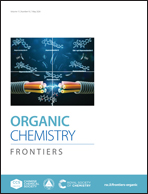Thiourea as a precatalyst for the electron donor–acceptor complex photoactivation platform of oxime esters†
Abstract
A novel electron donor–acceptor (EDA) complex catalysis strategy has been developed, employing N,N′-bis[3,5-bis(trifluoromethyl)phenyl]thiourea as a pre-catalyst and a base as a pre-catalyst initiation switch to generate iminyl radical intermediates from oxime esters via a single-electron reduction process under blue LED irradiation. This approach not only in situ converts a cost-effective and stable precursor into an electron donor for the catalytic system but also achieves the regeneration of the donor species. By utilizing 2–5 mol% of thiourea, a wide range of nitrogen-containing compounds, including pyrrolines, ketonitriles, phenanthridines, pyridines, and quinolines, were successfully synthesized, emphasizing the versatility of this approach. The pivotal roles of the pre-catalyst, base, and blue LED irradiation were verified through control experiments. Mechanistic studies and density functional theory calculations indicate that the generated thiouronyl anions serve as catalytic electron-donor species under blue light irradiation, enabling the single-electron reduction of oxime esters to form iminyl radical intermediates.



 Please wait while we load your content...
Please wait while we load your content...